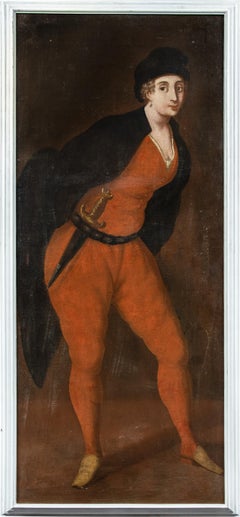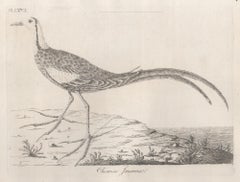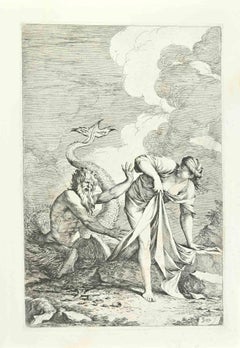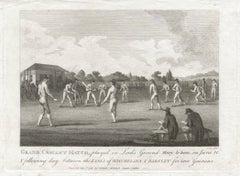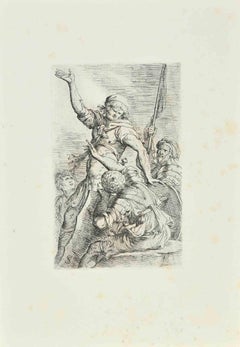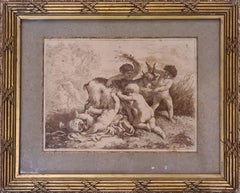18th Century Art
to
704
3,314
1,071
390
248
300
Overall Width
to
Overall Height
to
7,555
20,989
156,627
235,232
1,865
2,214
4,765
6,460
5,818
13,088
19,569
25,068
17,312
13,351
5,324
2,236
1,126
40
18
9
3
1
2,719
2,120
369
3,122
1,555
1,061
913
863
691
603
436
404
366
309
272
263
188
173
158
142
123
120
116
3,098
1,242
911
786
474
159
127
87
82
74
1,215
3,016
3,343
836
Period: 18th Century
Venetian Rococò painter - 18th century mask figure painting - Pantalone Carnival
Located in Varmo, IT
Venetian master (18th century) - Mask of Pantalone.
161 x 68 cm without frame, 169.5 x 76.5 cm with frame.
Antique oil painting on canvas, in a white lacquered wooden frame (not si...
Category
Rococo 18th Century Art
Materials
Oil, Canvas
$3,563 Sale Price
45% Off
Chinese Jacana, 18th century bird engraving by John Latham
By John Latham
Located in Melbourne, Victoria
Copper-line engraving. 1781. From John Latham's 'General Synopsis of Birds' 1781-1785, and its Supplements. Plate number top left. Laid paper.
John Latham was the leading English or...
Category
Naturalistic 18th Century Art
Materials
Engraving
Glaucus and Scylla - Etching after Salvator Rosa - 18th Century
Located in Roma, IT
This etching, representing Glaucus and Scylla, is an 18th century copy after Salvator Rosa (ca. 1661).
Signed lower right “S.Rosa”
The state of preservation is very good. Foxings d...
Category
Old Masters 18th Century Art
Materials
Etching
Grand Cricket Match at Lord's Ground, Marylebone, sport engraving, 1793
Located in Melbourne, Victoria
Title : 'Grand Cricket Match, played in Lord's Ground Mary-le-bone, on June 20th and following day between the Earl's of Winchelsea and darnley for 1000 Guineas.'
Publication line ...
Category
Victorian 18th Century Art
Materials
Engraving
Four Soldiers, one with Flag - Etching after Salvator Rosa - 18th Century
Located in Roma, IT
This etching, representing Four soldiers, one with flag, is an 18th century copy after Salvator Rosa and it is from the series of capricci with soldiers, called Figurine.
The first ...
Category
Old Masters 18th Century Art
Materials
Etching
The Harvest, Cherubs Disporting with a Goat, Fine Framed 18th Century Engraving
By Jean Jacques Lagrenée the Younger
Located in Cotignac, FR
Fine 18th century engraving by French artist Jean-Jacques Lagrenée. Presented with hand cut mount and gilt filet in fine wood and gilt 'ribbon and reed' frame.
Very charming renditi...
Category
18th Century Art
Materials
Paper, Printer's Ink
Madonna and Donor (an Ecclesiastic)
Located in Brooklyn, NY
Reproduction from a collection of drawings by Flemish and Dutch masters of the XV-XVII Centuries preserved in the Albertina Collection in Vienna, Austria. Published by Campbell Dodgs...
Category
Renaissance 18th Century Art
Materials
Lithograph
$72 Sale Price
20% Off
Antique French Neoclassical Rococo Bronze Figural Group of Wine Bacchantes 1762
Located in Portland, OR
A fine antique bronze figural group of Bacchantes by Claude Michel (Clodion) ( 1738– 1814).
The bronze depicts a pair of bacchantes, the female followers of Bacchus the Roman god of ...
Category
Rococo 18th Century Art
Materials
Bronze
The Yacou, 18th century bird engraving by John Latham
By John Latham
Located in Melbourne, Victoria
Copper-line engraving. 1781. From John Latham's 'General Synopsis of Birds' 1781-1785, and its Supplements. Plate number top left. Laid paper.
John Latham was the leading English or...
Category
Naturalistic 18th Century Art
Materials
Engraving
Ancient View of Paris - Etching - 1748
Located in Roma, IT
Etching on paper realized in 1748.
Very good condition except for some minor foxing.
Includes a wooden frame cm. 27.5x41.5
Category
Modern 18th Century Art
Materials
Etching
Ancient Roman Fresco - Original Etching by Giovanni Morghen - 18th Century
Located in Roma, IT
Ancient Roman Fresco from the series "Antiquities of Herculaneum", is an original etching on paper realized by Giovanni Morghen in the 18th Century.
Signed on the plate.
Good condi...
Category
Old Masters 18th Century Art
Materials
Etching
Vaso Cinerario di Gran Mole, etching from "Vases, Candelabras, Grave, Stones..."
Located in Roma, IT
Well-knowned as an architect and an archaeologist, undoubtedly Giovanni Battista Piranesi, is the most important engraver of the 18th century: the leading artist in this field in the...
Category
18th Century Art
Materials
Engraving, Etching
Maniere de Disposer La Menuiserie, Roubo French cabinetmaking design engraving
Located in Melbourne, Victoria
'Maniere de Disposer La Menuiserie pour Recevoir La Sculpture'
French copper-line engraving by Berthault after Andre Jacob Roubo (1739–1791). 18th century laid watermarked paper.
F...
Category
French School 18th Century Art
Materials
Engraving
Apollo Emerging from the Waters
By Simon Thomassin
Located in Houston, TX
Antique engraving titled "Apollon Sortant Des Eaux" over 250 years old by Simon Henri Thomassin, circa 1720. Signed lower right.
Original artwork on paper displayed on a white ma...
Category
18th Century Art
Materials
Engraving
18th Century Italian oil on copper, Raphael School
Located in New York, NY
18th Century Italian oil on copper portrait in the style of Raphael. Excellent condition.
Category
18th Century Art
Materials
Copper
Portrait of a Lady in a White Dress - 18th Century Watercolour
By John Downman
Located in London, GB
John Downman
1750-1824
Portrait of a Lady in a White Dress
Pencil, stump and watercolour, heightened with white chalk, signed and dated 1784
Imag...
Category
18th Century Art
Materials
Watercolor, Paper
Mary Magdalene - Oil on Canvas by Italian School 19th cent.
Located in Roma, IT
Oil on canvas. cm 60.5 x 2 x 50
Nice Oil painting (Italian School of XIX century) with a rapid sign and intense colors backgrpound. Some color cracking on left margin and top edge, ...
Category
Modern 18th Century Art
Materials
Oil
$3,563 Sale Price
25% Off
Ancient Roman Scene - Etching by Nicolò Fiorillo - 18th Century
Located in Roma, IT
Ancient Roman Scene from the series "Antiquities of Herculaneum", is an etching on paper realized by Nicola Fiorillo in the 18th Century.
Signed on the plate.
Good conditions with ...
Category
Old Masters 18th Century Art
Materials
Etching
Elderly Shepherd Leaning on a Staff (after Parmigianino)
Located in Middletown, NY
A lovely chiaroscuro woodcut by Antonio Maria Zanetti the elder after a work by Parmigianino (Girolamo Francesco Maria Mazzola). Printed on cream laid paper, laid down to a cream lai...
Category
Old Masters 18th Century Art
Materials
Laid Paper, Woodcut
Newstead in Nottinghamshire. Paul Sandby C18th landscape engraving
By Paul Sandby
Located in Melbourne, Victoria
'Newstead in Nottinghamshire, the Seat of Lord Byron'
Engraving by Thomas Malton after Paul Sandby (1731-1809).
From Paul Sandby's 'The Virtuosi's Museum, Containing Select Views i...
Category
Naturalistic 18th Century Art
Materials
Engraving
"Century Seascape"
Located in Edinburgh, GB
Seascape with Ships and Figures
Oil on canvas
Framed: 58 x 65 cm Canvas: 42 x 30 cm
No signatured
This elegant 18th-century seascape captures a tranquil yet dynamic maritime scene, ...
Category
Realist 18th Century Art
Materials
Canvas, Oil
The Three Magi
Located in New York, NY
Provenance: Private Collection, Spain.
Known as Peruvian alabaster for its translucency and workability, Piedra de Huamanga is a highly prized material from the province of Ayacucho in Peru. In the 17th and 18th centuries, local craftsman in the town of Huamanga began to specialize in the production of small-scale, polychrome religious sculptures made from this distinctive stone. Huamanga sculptures are among the most accomplished examples of carving from the Spanish Americas, where polychrome wood sculpture was a far more common sculptural medium. These works, which were created as independent sculptures or as sculptural groups—such as our three Magi—were intended for ecclesiastical as well as domestics settings.
Our three figures likely formed part of a larger Nativity group—a New World variant of the tradition of the Neapolitan Crèche...
Category
18th Century Art
Materials
Alabaster
18th Century Etching of Ancient Roman Architectural Objects by Giovanni Piranesi
Located in Alamo, CA
A. Tigna Protensa Super Media Epistylia, B. Praecisiones Tigorum Quaqua Versus Extrinsectus Apparentium, C. Opae Extremitates Tigorum Contintes, Fig. I, plate 88 from "Vasi, Candelab...
Category
Old Masters 18th Century Art
Materials
Etching
Les Bergers Romains, landscape with Roman ruins, 18th century engraving
Located in Melbourne, Victoria
Les Bergers Romains
Copper-line engraving by Jean Jacques Leveau (1729-1786) after Pierre Mettay (1728-1759). C1755.
Proof, before lettering. Laid, watermarked paper.
A landscap...
Category
French School 18th Century Art
Materials
Engraving
Francesco Casanova (Venetian painter) - 18th century landscape - Battle scene
Located in Varmo, IT
Francesco Casanova (London 1727 – Mödling 1803) attributed to - Battle scene on horseback.
22.5 x 17.5 cm.
Oil on canvas, unframed (not signed).
- Label: “CASANOVA Francesco Giuse...
Category
Rococo 18th Century Art
Materials
Canvas, Oil
Anthony Friedkin, Rick Dano, Malibu, Surfer, Smoking, Car, June Gloom, B&W
Located in Zurich, CH
Anthony FRIEDKIN (*1949, America)
Clockwork Malibu, Rick Dano on P.C.H., Malibu, California, U.S.A., 1977
Silver Gelatin Print, later print
40.6 x 50.8 cm (16 x 20 in.)
Edition of 25...
Category
Contemporary 18th Century Art
Materials
Silver Gelatin
Venetian School: Neoclassical banquet scene with angels and putti.
Located in Middletown, NY
Brownish black ink on dark cream, handmade, laid paper, 8 1/4 x 10 1/4 inches (208 x 260 mm). Uniform age tone with several scattered, unobtrusive spots of brown discoloration, consistent with age. Right top corner loss, evenly trimmed, paper tape remnants at top left corner, recto. Collector's stamp in blue ink ("PRB"), lower left corner, recto. On the verso is a neoclassical graphite and brown ink study of a procession showing a woman being carried in a birthing sedan chair. The woman is being carried backwards, with putti, and horn players, leading her up an embankment, across a river. In her wake we see a crowned man...
Category
Old Masters 18th Century Art
Materials
Handmade Paper, Ink, Laid Paper
The Battle Of Sluys (1340), oil on canvas, 100 Hundred Years War Naval Scene
Located in Blackwater, GB
The Battle Of Sluys (1340), oil on canvas, 16th/17th Century
Rare account of the opening engagement of The Hundred Years War (1337-1453)
Fine huge antique history painting depictin...
Category
18th Century Art
Materials
Canvas, Oil
A Night Dance by Women in Tonga: Original 18th C. Engraving, Cook's 3rd Voyage
By John Webber
Located in Alamo, CA
"A Night Dance by Women in Hapaee" is an original 18th century engraving from a drawing by John Webber (1751-1793), who was the artist who accompanied Captain Cook on his third voyag...
Category
18th Century Art
Materials
Engraving
Ancient Roman Temple - Etching by Nicola Vanni - 18th Century
Located in Roma, IT
Temple from "Antiquities of Herculaneum" is an etching on paper realized by Nicola Vanni in the 18th Century.
Signed on the plate.
Good conditions.
The etching belongs to the prin...
Category
Old Masters 18th Century Art
Materials
Etching
Portrait du XVIIIe siècle attribué à Pierre Gobert (1662/1744)
By Pierre Gobert
Located in GOUVIEUX, FR
Portrait du XVIIIe siècle attribué à Pierre Gobert
Nous vous présentons un portrait remarquable, daté de la première moitié du XVIIIe siècle, attribué à Pierre Gobert, un peintre fra...
Category
18th Century Art
Materials
Oil
18th C. Portrait of Edward Stanley from Henry VIII's Court after Holbein Drawing
By Hans Holbein
Located in Alamo, CA
This is an 18th century engraved portrait of "Edward Stanley" created by Francesco Bartolozzi (1728–1815), after a drawing by Hans Holbein the Younger (1497- 1543) in the 16th century. Holbein was the official artist in the court of King Henry VIII. Bartolozzi used both etching and stipple engraving techniques to create the work which was published by John Chamberlaine in London in 1793 in "The Book of Imitations of Original Drawings by Hans Holbein in the Collection of His Majesty".
Edward Stanley, 3rd Earl of Derby...
Category
Old Masters 18th Century Art
Materials
Engraving, Etching
Ancient Roman Architecture: Framed Original 18th C. Etching by G. Piranesi
Located in Alamo, CA
"A sua Eccellenza il Signor Henry Hope Cav. Scozzese Amatore delle Belle Arti from "Vasi, Candelabri, Cippi, Sarcofagi, Tripodi, Lucerne, Ed Ornamenti Antichi", (Vases, candelabra, grave stones, sarcophagi, tripods, lamps, and ancient ornaments) is an etching by Giovanni Battista Piranesi, published in 1778. It depicts stone caryatids...
Category
Old Masters 18th Century Art
Materials
Etching
George Edwards: 18th Century Engravings of Ducks And Wading Birds
Located in Richmond, GB
George Edwards: ""A History of Uncommon Birds"", 1749-1761.
A prominent English naturalist and ornithologist, George Edwards (1694 -1773) is best known for his work, ""A Natural His...
Category
18th Century Art
Materials
Watercolor
George Edwards: 18th Century Engravings of Ducks And Wading Birds
Located in Richmond, GB
George Edwards: ""A History of Uncommon Birds"", 1749-1761.
A prominent English naturalist and ornithologist, George Edwards (1694 -1773) is best known for his work, ""A Natural His...
Category
18th Century Art
Materials
Watercolor
George Edwards: 18th Century Engravings of Ducks And Wading Birds
Located in Richmond, GB
George Edwards: ""A History of Uncommon Birds"", 1749-1761.
A prominent English naturalist and ornithologist, George Edwards (1694 -1773) is best known for his work, ""A Natural His...
Category
18th Century Art
Materials
Watercolor
Ancient Roman Scene - Etching F. Campana - 18th Century
Located in Roma, IT
Ancient Roman Scene from the series "Antiquities of Herculaneum", is an etching on paper realized by Ferdinando Campana in the 18th Century.
Signed on the plate.
Good conditions wi...
Category
Old Masters 18th Century Art
Materials
Etching
Ancient Views of Paris - Etching - 1748
Located in Roma, IT
4 Etchings on paper realized in 1748. Each cm. 17x22.
Very good condition except for some minor foxing.
Includes a wooden frame cm. 27.5x41.5
Category
Modern 18th Century Art
Materials
Etching
Enlightenment Italian painter - 18th century figure painting - Portrait - Italy
Located in Varmo, IT
Italian painter (18th century) - Portrait of a gentleman with aphorism.
92 x 68 cm.
Antique oil painting on canvas, without frame (not signed).
- Inscription: "There are more madm...
Category
Rococo 18th Century Art
Materials
Canvas, Oil
$1,779 Sale Price
25% Off
Animal Figures - Original Etching by Various Old Masters - 1750s
Located in Roma, IT
Animal Figures from Ancient Rome, from the Series "The Antiquities of Herculaneum Exposed", is an original etching from the end of the 18th century, made by Various Old Masters.
In ...
Category
Old Masters 18th Century Art
Materials
Etching
Sheltering from the storm / - Romantic landscape illuminated by lightning bolt -
Located in Berlin, DE
George Morland (1763 London - 1804 Brighton). Sheltering from the Storm. Oil on canvas, relined, 37.5 x 29.5 cm (visible size), 53.5 x 45.5 cm (...
Category
Romantic 18th Century Art
Materials
Oil
Mercurio / Mercury
Located in Middletown, NY
A lovely, early drawing of the Roman god Mercury.
Pen and brown ink on cream laid paper, with a partial crown and shield watermark, 7 1/4 x 4 7/8 inches (184x 123 mm) (matrix). In go...
Category
Old Masters 18th Century Art
Materials
Ink, Handmade Paper, Laid Paper
The Royston Crow (Hooded Crow) /// Thomas Pennant Ornithology Bird Animal Art
By Thomas Pennant
Located in Saint Augustine, FL
Artist: Thomas Pennant (Welsh, 1726-1798)
Title: "The Royston Crow (Hooded Crow)" (Plate D1)
Portfolio: The British Zoology, Class II: Birds
Year: 1761-1766 (First edition)
Medium: O...
Category
Old Masters 18th Century Art
Materials
Watercolor, Engraving, Laid Paper
Ricinus Africanus Maximus N. 867 J.W. Weinman original engraving 1737
Located in Paonia, CO
Mezzotint Engraving with Some Hand Coloring image size 15.25 x 10 from Johan Wilhelm Weinmann’s ( 1683-1741 ) Phytanthoza Iconographia, a comprehensive scientific eight volume set w...
Category
18th Century Art
Materials
Engraving
Hand-Colored Madagascar Parrot Engraving
Located in New York, NY
Original engraving, hand-colored at the time of publication, after the work of George Edwards from "Sammlung verschneider auslandischer und seltener Vogel" by Johann Michael Seligmann. Tab IX. Le Perroquet...
Category
18th Century Art
Materials
Laid Paper
Benjamin West, history painter, portrait, soft ground etching, 1809
Located in Melbourne, Victoria
'Benj. West RA'
Soft ground etching by William Daniell RA (1769-1837) after George Dance the Younger (1741-1825), 1809.
Benjamin West PRA (1738 – 1820) was an Anglo-American painter of historical scenes around and after the time of the American War of Independence...
Category
English School 18th Century Art
Materials
Engraving, Etching
George Edwards: 18th Century Engravings of Ducks And Wading Birds
Located in Richmond, GB
George Edwards: ""A History of Uncommon Birds"", 1749-1761.
A prominent English naturalist and ornithologist, George Edwards (1694 -1773) is best known for his work, ""A Natural His...
Category
18th Century Art
Materials
Watercolor
Italian Capriccio View with Classical Ruins and Santa Maria della Salute, Venice
By Gaetano Vetturali (Lucca, 1701-1783)
Located in Stockholm, SE
A Venetian capriccio view with classical architectural ruins and in the background the church of San Giorgio Maggiore and the Church of Santa Maria della Salute next to the Grand Can...
Category
Old Masters 18th Century Art
Materials
Canvas, Oil
Seaman in petticoat breeches and slops, smoking a pipe, carrying a carpetbag.
Located in Middletown, NY
English School, 18th century
Pen and black ink with gray wash on cream laid paper, 9 1/4 x 5 inches (238 x132 mm). 1/4 inch repaired loss, top center, to the left of the figure’s h...
Category
Realist 18th Century Art
Materials
Ink, Watercolor, Laid Paper, Pen
4 plates from The Wondrous Transformation of Caterpillars & their Strange Diet..
Located in Middletown, NY
Four plates from The Wondrous Transformation of Caterpillars and their Strange Diet of Flowers. “Wolfsmelk Rupsen;" “Wolfsmilch, Raupe und Schmetterling" Amsterdam: J F Bernard, 1730. Each an engraving with hand coloring in watercolor and gouache printed on one sheet of watermarked Honig cream laid paper, each measures 6 1/4 x 5 inches (157 x 121 mm), sheet measures 20 5/8 x 14 inches (522 x 355 mm), full margins. With handling creases in the lower right sheet quadrant, as well as minor, loose cockling, otherwise in very good condition. The colors are superb with exceptionally fresh and bright saturation. Engraved between 1679 and 1683, printed 1730. Plates included: CI; CII; CIII & CIV.
MARIA SIBYLLA MERIAN was one of the most highly respected entomologists of the 17th century, and remains today one of the field's most significant figures. A German-born naturalist and scientific illustrator, she reared herself on the study of caterpillars, and made tremendous contributions to the knowledge of the life cycles of numerous species. Until her detailed and careful study of the process of metamorphosis it was thought that insects were "born of mud," through spontaneous generation.
Trained as a miniature painter by her stepfather, she published her first book of illustrations in 1675, at the age of 28. In 1679, Merian published the first volume of the two-volume series on caterpillars, The Wondrous Transformation of Caterpillars and their Strange Diet of Flowers; the second volume followed in 1683. Each volume contained 50 plates that she engraved and etched. In 1699, Merian traveled to Dutch Guiana...
Category
Naturalistic 18th Century Art
Materials
Engraving, Watercolor
Old Church - Original Etching by F.E. Weirotter - Half of 1700
Located in Roma, IT
Old Church is an original artwork realized by Franz Edmund Weirotter in the first half of the XVIII Century.
Original Etching on paper. Passepartout included (cm 37 x 55).
Signed...
Category
Modern 18th Century Art
Materials
Etching
Johann Weinmann : Mezzotint engraving in a decalcomania frame.
Located in Richmond, GB
From a wonderful selection of hand-coloured mezzotint engravings from: "Phytanthoza Iconographia", c1739, presented in a hand-made parcel-gilt, ebonised and decalcomania frame...
Category
18th Century Art
Materials
Engraving, Mezzotint
Roman Fresco - Etching by Ferdinando Campana - 18th Century
Located in Roma, IT
Roman Fresco from "Antiquities of Herculaneum" is an etching on paper realized by Ferdinando Campana in the 18th Century.
Signed on the plate.
Goo...
Category
Old Masters 18th Century Art
Materials
Etching
Paris : Place Louis-le-Grand, Now Place Vandôme - Original etching, Signed
Located in Paris, IDF
Jacques Rigaud (c. 1671/91-1754)
Paris : Place Louis-le-Grand, Now Place Vandôme
Original etching
Signed in the plate
On Arches vellum 38 x 56.5 cm (14.9 x 22.2 inch)
INFORMATION :...
Category
Other Art Style 18th Century Art
Materials
Etching
Old Master Drawing, Roccoco, 18th Century, German Artist, Animal Drawing
By Johann Martin Metz
Located in Greven, DE
Black chalk, partly washed, on paper, sheet 27.5 x 19.7 cm
Plain gold moulding, 44.8 x 36 cm
The Rhenish still life painter Johann Martin Metz was ...
Category
Rococo 18th Century Art
Materials
Paper, Crayon
$760 Sale Price
20% Off
Late 18th – early 19th century landscape with two young girls, and goat
Located in San Francisco, CA
Late 18th – early 19th century landscape with two young girls, and goat. Signed allegedly low capital R. T. Relined/restored. Oil on canvas. 12.75 x 16.
Category
18th Century Art
Materials
Canvas, Oil
"Inside of a House in Nootka Sound" (Canada) from Captain Cook's 3rd Voyage
By John Webber
Located in Alamo, CA
"The Inside of a House in Nootka Sound" is an engraving created by William Sharp (1749-1824), from a drawing by John Webber (1752-1793), who was the artist on Captain James Cook's 3rd and final voyage of discovery. It is Plate 65 in "A Voyage to the Pacific Ocean Undertaken by the Command of His Majesty, for Making Discoveries in the Northern Hemisphere", the official British Admirality sanctioned journal published upon completion of the voyage in London in 1784 by Strahan & Cadell.
This engraving is presented in a Koa wood frame and a white mat. There are occasional tiny faint spots, but the print is otherwise in very good condition. Koa wood is legendary in Hawaii. Not only is this amazing wood native to Hawaii, but it is known for the deep rich colors and varied grain pattern. Koa has an honored heritage in Hawaii and is highly revered and sacred. The word “koa” means “warrior” in Hawaiian. The warriors of King Kamehameha the Great, created canoes and weapons from a wood plentiful on the Big Island of Hawaii. This wood became synonymous with the warriors themselves, and it became known as koa.
There are three other engravings listed form the official journal of Captain Cook's 3rd voyage available that are presented in identical Koa wood frames and mats. They would make a wonderful grouping for a display of 2, 3 or 4 prints. Please see listings: LU117324682432, LU117324684022, LU117324684062. A discount is available for a grouping depending on the number of items included.
Nootka Sound is on the west coast of Vancouver Island, British Columbia, Canada. It was explored by Captain Cook in 1778 after he discovered Hawaii during his 3rd voyage. He originally named it King George's Sound, but did record Nootka Sound, which he thought was its native name. Hawaii was originally called The Sandwich Islands in honor of The Earl of...
Category
Realist 18th Century Art
Materials
Engraving
In The Hall - Etching by Pierre-Edmé Babel - 1771
Located in Roma, IT
In The Hall is an etching realized in 1771 by Pierre-Edmé Babel.
Titled and Signed on the plate.
The artwork is depicted through confident strokes in a well balanced composition.
...
Category
Modern 18th Century Art
Materials
Etching
Ancient Roman Fresco of Animals - Original Etching by V. Aloja - 18th Century
Located in Roma, IT
Ancient Roman Fresco of Animals, from the series "Antiquities of Herculaneum", is an original etching on paper realized by Vincenzo Aloja in the 18th century.
Signed on the plate on...
Category
Old Masters 18th Century Art
Materials
Etching
Red & Black Woodpeckers: An 18th Century Hand-colored Bird Engraving by Martinet
Located in Alamo, CA
This is an original 18th century hand-colored copperplate engraving of a pair of red and black woodpecker birds entitled "1. Pie Roux, de Cayenne 2. Petit Pie Noir, de Cayenne (Red a...
Category
Naturalistic 18th Century Art
Materials
Engraving
